STANISLAW JAN ANTONI BIEGA, b. 13-XII-1862 in Sanok, d. 19-IV-1923 in Warsaw, my
grandfather. There are many references for his life. The following edited translation from the Polish Biographical
Encyclopedia, vol 2, page 25, summarizes his professional life:
Stanislaw John Anthony BIEGA (1862-1923), a social worker in Galicia. He was born 13 Dec. 1862 in
Sanok, graduated from high school in Przemysl in 1882 and from the School of Law (at the Jagellonian
University) in Cracow in 1887, when he entered the Government Tax Service in Sanok. He was transferred to
Kolomiya in 1903. In 1905, when he was Senior Commissioner, he resigned and joined the newspaper "Slowo
Polskie" (Polish Word) in Lwów, where he continued until June 1915.
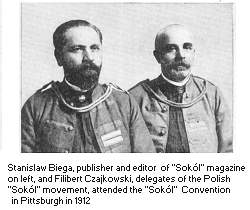 From his youngest days he was active in social and political life. He was one of the founders of "Sokół" in
Sanok and was instrumental in the building of its assembly hall. In Kolomyia he continued working with Sokół
and then in Lwów he became the General Secretary of the Union of Polish Sokols, and organized the first National
Sokol Jamboree in Cracow in 1910. He was instrumental in the organizing of the Polish Boy Scout movement in
1910. In recognition of his services, the Polish National Sokol Union in the U.S.A. elected him an honorary
member at its Annual Meeting in 1912 (in Pittsburgh). Both in Sanok and Kolomya he was also active in the
Association for People's Schools. He traveled around making speeches and giving lectures at the various local
groups. From 1905 till 1915 as Editor of the provincial section of the newspaper "Słowo Polskie" he did much to
strengthen Polish nationalism in eastern Galicia. He was also active in the political party "Stronnictwo Narodowe"
(National Democrats), and was secretary of the Central Committee of the party. He opposed the forming of Polish
military units to fight with the Central Powers (Germany, Austria) in the First World War, and was instrumental
in dissolving the Eastern Legion in Mszana Dolna, when the Austrian Government refused to provide any
guarantees for an independent Poland.
From his youngest days he was active in social and political life. He was one of the founders of "Sokół" in
Sanok and was instrumental in the building of its assembly hall. In Kolomyia he continued working with Sokół
and then in Lwów he became the General Secretary of the Union of Polish Sokols, and organized the first National
Sokol Jamboree in Cracow in 1910. He was instrumental in the organizing of the Polish Boy Scout movement in
1910. In recognition of his services, the Polish National Sokol Union in the U.S.A. elected him an honorary
member at its Annual Meeting in 1912 (in Pittsburgh). Both in Sanok and Kolomya he was also active in the
Association for People's Schools. He traveled around making speeches and giving lectures at the various local
groups. From 1905 till 1915 as Editor of the provincial section of the newspaper "Słowo Polskie" he did much to
strengthen Polish nationalism in eastern Galicia. He was also active in the political party "Stronnictwo Narodowe"
(National Democrats), and was secretary of the Central Committee of the party. He opposed the forming of Polish
military units to fight with the Central Powers (Germany, Austria) in the First World War, and was instrumental
in dissolving the Eastern Legion in Mszana Dolna, when the Austrian Government refused to provide any
guarantees for an independent Poland.
During the Russian occupation of Lwów, 1914-15, he was one of the founders of the Lwów Rescue
Committee to assist the refugees from Galicia. In June 1915 he moved to Kiev, where he continued the work of the
Committee. There also he was active in organizing Polish political and military units in the Ukraine. He was also a
member of the Polish Council in Moscow, the central unit of all the Polish organizations in Russia assisting the
refugees. Finally he was also a member of the Polish Council of Unity in Moscow, which was the equivalent in
Russia of the Polish National Committee in Paris.
 In the fall of 1918 he returned to Poland (now liberated) and settled in Warsaw. Once more he devoted
himself to the Sokół organization and achieved the forming of a Union of Polish Sokol Clubs, of which he was
Vice President. He organized a Jamboree in Warsaw in 1921. He died in Warsaw 19 April 1923. He is buried in
the Powazki Cemetery, Warsaw, Poland, (close to marker #221). A prominent red sandstone memorial, with a
grieving falcon on top, was erected in his memory by the National Sokól Society in 1923.
In the fall of 1918 he returned to Poland (now liberated) and settled in Warsaw. Once more he devoted
himself to the Sokół organization and achieved the forming of a Union of Polish Sokol Clubs, of which he was
Vice President. He organized a Jamboree in Warsaw in 1921. He died in Warsaw 19 April 1923. He is buried in
the Powazki Cemetery, Warsaw, Poland, (close to marker #221). A prominent red sandstone memorial, with a
grieving falcon on top, was erected in his memory by the National Sokól Society in 1923.
My father's memoirs provide some more details of his personal life. In 1890 he married Maria, daughter of
Stanislaw Baumann and Jadwiga Lubowiecka of a local family of landowners. Stanislaw Baumann was an
engineer and one of the official surveyors for the Sanok county. His family originated from western Poland and had
been forced to flee to Galicia after the 1830 insurrection against Russians. His grandfather had been awarded the
most prestigious military decoration "Virtuti Militarii" for his valor in one of the battles for freedom. Maria had
two older brothers -- Boleslaw, who later became an official of the Florianka Insurance Company in Cracow, and
Stanislaw who had a son Tadeusz, later a school friend of my father. Stanislaw Baumann maintained close contact
with his daughter's children after her death and gave generously to each of them in his will. He died in Sanok in
1920, having been a widower for 20 years.
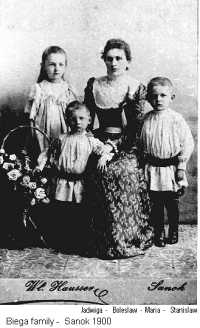 Stanislaw and Maria Biega had three children, all born in Sanok -- Jadwiga in 5-II-1891, Stanislaw 5-IX-1893 and Boleslaw (my father) 27-IV-1896. Her health deteriorated particularly after the move to Kolomiya, where
she spent much time at home with the children while her husband was busy pursuing his career and political
interests. In 1905 they separated. The two boys returned to Sanok to attend school under the supervision of Uncle
Leopold. Maria moved to Lwów with Jadwiga, who was placed in a girl's boarding school. She had developed
tuberculosis and, in spite of several sojourns in spas and on the Dalmatian coast, her condition worsened and in
August 1908 she died.
Stanislaw and Maria Biega had three children, all born in Sanok -- Jadwiga in 5-II-1891, Stanislaw 5-IX-1893 and Boleslaw (my father) 27-IV-1896. Her health deteriorated particularly after the move to Kolomiya, where
she spent much time at home with the children while her husband was busy pursuing his career and political
interests. In 1905 they separated. The two boys returned to Sanok to attend school under the supervision of Uncle
Leopold. Maria moved to Lwów with Jadwiga, who was placed in a girl's boarding school. She had developed
tuberculosis and, in spite of several sojourns in spas and on the Dalmatian coast, her condition worsened and in
August 1908 she died.
Undoubtedly there are further references to Stanislaw Biega in the archives of the Gymnastic Society
"Sokól", known in the U.S.A. as the Falcon Society, as well as the archives of the newspaper "Slowo Polskie"
which was published in Lwów from the 1880's until 1939.
Return to Index.
To complete this family record another generation needs to be filled in briefly, that of Stanislaw Jan's
children. Each of their children will be able, if they wish, to add more detail for their own family records.
JADWIGA, b.5-II-1891. d.1983 in Warsaw. She attended the girl's school in Sanok, later in Kolomiya. In 1905 she was
enrolled in the well known school of Zofia Strzalkowska. After her graduation she received employment at this
school as a teacher and an assistant in the operation of the boarding school. She remained in Lwów throughout the
war.
In 1918 she rejoined her father in Warsaw. There she joined the staff of the Institute for Deaf and Dumb as a
teacher. She stayed in this position until 1939. 14-XI-1920 she married Boleslaw Brodzki who was an
administrator at the Institute. He was born 19-VIII-1886, and died 21-III-1939. They had two children -- MARIA,
b. 1921 and JAN, b. 1923. During the German occupation, and until 1974 she worked as a teacher in a school for
retarded children in Warsaw. After her retirement she lived with her daughter's family in Warsaw until her death in 1983. Maria worked for the Polish Scout organization in Warsaw until she was 80 years old.
Jadwiga's son Jan Brodzki fought in the Warsaw Uprising in 1944. After several months in P.O.W. camp, he arived in London. Later he worked for Radio Free Europe in Munich, then for the Polish section of B.B.C. in London until his retirement in 1990.
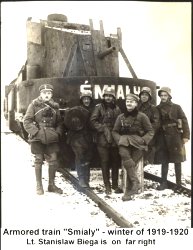 STANISLAW, b. 5-IX-1893. He completed high school in Sanok in 1911 and enrolled in the Technical
University (Politechnika) in Lwów. He joined the paramilitary organization Sokole Druzyny Polowe which became
part of the Eastern Legion (Legion Wschodny). After its dissolution in Mszana Dolna (September 1914), he crossed the lines and
returned to Russian occupied Lwów together with his father and brother. When the Russian retreat commenced, all
three went to Kiev. He joined the Polish army, I Corps, organized in Russia by Gen. Dowbór-Musnicki in 1918. After fighting started with the Bolsheviks, 12-I-1918 he volunteered for service on the armored train under the
command of Lt. Malagowski and took part in several battles, at Zlobin and Czerwony Krzyz. At the end of
September 1918 he arrived in Cracow. Together with Malagowski he organized another armored train "Smiały"
and they moved east to break the siege of Lwów by Ukrainians. Later they fought on the Byelorussian front against
the Bolsheviks. He was awarded the prestigious "Virtuti Militarii" (#8195) for his valor.
STANISLAW, b. 5-IX-1893. He completed high school in Sanok in 1911 and enrolled in the Technical
University (Politechnika) in Lwów. He joined the paramilitary organization Sokole Druzyny Polowe which became
part of the Eastern Legion (Legion Wschodny). After its dissolution in Mszana Dolna (September 1914), he crossed the lines and
returned to Russian occupied Lwów together with his father and brother. When the Russian retreat commenced, all
three went to Kiev. He joined the Polish army, I Corps, organized in Russia by Gen. Dowbór-Musnicki in 1918. After fighting started with the Bolsheviks, 12-I-1918 he volunteered for service on the armored train under the
command of Lt. Malagowski and took part in several battles, at Zlobin and Czerwony Krzyz. At the end of
September 1918 he arrived in Cracow. Together with Malagowski he organized another armored train "Smiały"
and they moved east to break the siege of Lwów by Ukrainians. Later they fought on the Byelorussian front against
the Bolsheviks. He was awarded the prestigious "Virtuti Militarii" (#8195) for his valor.
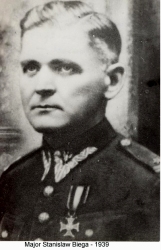 In 1920 he was a subaltern in the Machine Battalion of the Wielkopolska Officer School (Wielkopolska
Szkoła Podchorążych). He was promoted to Lieutenant in 1921 and to Captain in 1923, then he was attached to the
10th. Engineering Regiment at Modlin (near Warsaw). He married Irena Helbich 4-I-1923 and their son
STANISLAW was born 4-III-1925. In 1927 he was attached to the Electrotechnical Battalion. 1927-29 he studied
at the Superior War Academy (Wyzsza Szkola Wojenna). The next two years he was attached to HQ. X Corps, and
from 1933 to 1937 he was Training Officer for the 2nd. Engineer Brigade at Powazki (Warsaw). Irena died 24-X-1937, after a long illness.
In 1920 he was a subaltern in the Machine Battalion of the Wielkopolska Officer School (Wielkopolska
Szkoła Podchorążych). He was promoted to Lieutenant in 1921 and to Captain in 1923, then he was attached to the
10th. Engineering Regiment at Modlin (near Warsaw). He married Irena Helbich 4-I-1923 and their son
STANISLAW was born 4-III-1925. In 1927 he was attached to the Electrotechnical Battalion. 1927-29 he studied
at the Superior War Academy (Wyzsza Szkola Wojenna). The next two years he was attached to HQ. X Corps, and
from 1933 to 1937 he was Training Officer for the 2nd. Engineer Brigade at Powazki (Warsaw). Irena died 24-X-1937, after a long illness.
In 1937 he was promoted to Deputy Commander of the Engineer Battalion in Puławy (about 100km south of Warsaw). Here in 1938 he
married Eugenia Zukowska, a dentist. A baby boy, MACIEJ, was born in 1939 as the war broke out. Stanislaw
never saw his second son, because in March 1939 he was promoted to Major on the staff of Army Group "Poznan."
He fought in the battle of the river Bzura and in the defense of Warsaw. Taken prisoner he spent the next several
years at Oflag VIB Dössel where he was tragically killed by an Allied bombing error 27-IX-1944. He is buried in the cemetery there, together with 184 others killed in this tragic accident.
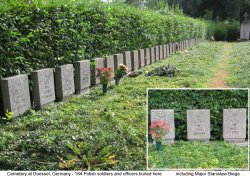 He was awarded
the Valiant Cross (Krzyż Walecznych) four times. During the winter of 1939-1940, Eugenia returned from the
Soviet occupied zone of Poland to Warsaw with her baby. In 1943 she was arrested by the Nazis and incarcerated
in the Rawensbrück concentration camp where she was subjected to brutal experiments from which she never fully
recovered. She returned after the war to Warsaw and died in 1990.
He was awarded
the Valiant Cross (Krzyż Walecznych) four times. During the winter of 1939-1940, Eugenia returned from the
Soviet occupied zone of Poland to Warsaw with her baby. In 1943 she was arrested by the Nazis and incarcerated
in the Rawensbrück concentration camp where she was subjected to brutal experiments from which she never fully
recovered. She returned after the war to Warsaw and died in 1990.
Stanisław's first son, also named Stanisław, fought in the underground army against the Nazis during WW II in the Holy Cross Mountains (Góry Świętokrzyskie). After the war he went to Australia, married an Australian girl Annette Smith. They have six children, see Biega in Australia .
Maciej stayed in Poland and became a sports journalist, winning the "Golden Pen" award of the Klub of Sports Writers. He married Renata Wołoszczuk and they have a son. Renata died in 1988, Maciej died 23-I-1993 in Warsaw. Their son, also named Stanisław, is an energetic defender of the environment and currently (2008) is a consultant in railroad affairs.
Back to Index.
 BOLESLAW JOZEF, b. 27-IV-1896. His story up to 1937 is covered in full in his memoirs dictated on
tape, now being edited by me. Further information is given in my book
"Thirteen Is My Lucky Number." A short
summary is included here to complete the narrative:
BOLESLAW JOZEF, b. 27-IV-1896. His story up to 1937 is covered in full in his memoirs dictated on
tape, now being edited by me. Further information is given in my book
"Thirteen Is My Lucky Number." A short
summary is included here to complete the narrative:
After his parent's separation in 1905, he and his brother lived in a boarding house operated by nuns while
they continued their schooling in Sanok. In 1910 he moved to his father's flat in the new "Slowo Polskie" building
in Lwów and ccompleted High School #3 in 1914. He participated in many activities of "Sokól" and belonged to the
first Boy Scout Troop in Galicia, which was established in 1910. He witnesses many of the meetings of prominent
figures in Polish political and cultural life who met in his father's flat. Many of these people played an influential
role in his later professional life.
Together with his brother and father he arrived in Kiev in late 1915. He attended the university and also
participated in the secret Polish organization "Zet." He joined the Carpathian Brigade which Gen. Haller had
brought over to the Russian side from the Austrians. He had some anxious moments when his unit was surrounded by the German
Army, but escaped from the train taking him to prison camp. Later he worked on the evacuation of the Brigade to
Murmansk for transportation to France. When the Bolshevik revolution created chaos in Ukraine he managed to
get to Warsaw in September 1918. Immediately he returned to university studies.
In January 1919 he and five others were selected to go to Paris for studies at the "Ecole des Sciences
Politiques" at the Sorbonne in Paris. During this time he fell in love with an English girl who was working for the
British delegation at the Versailles Peace Conference. In June 1921 he received his Diploma from the Sorbonne.
October 29 he married Marjorie Thomas in London. She was the youngest daughter of a retired Anglo-Irish career
officer in the British Army in India. They immediately went to Warsaw where he had been assigned to the
Economic Section of the Foreign Ministry. 21-VII-1922 their son Boleslaw Christopher was born. One year later
father was nominated to the position of Secretary at the Polish Legation in London. He worked with Edward Raczynski, who later became Polish Ambassador to Great Britain, finally Foreign Secretary, then President of Polish Government in Exile during World War II.
In August 1924 tragedy struck. While on holiday at Caen in France, Marjorie suffered a miscarriage while
swimming and died. The shock caused a crisis for Boleslaw, he developed tuberculosis. Fortunately it was
diagnosed quickly and a stay in Switzerland provided a complete cure. In November 1925 he married Baba Seely,
the daughter of a retired lawyer. In the meantime his diplomatic career was proceeding well. In 1928 he returned
to Warsaw and was shortly named Head of the Anglo-American desk in the Economic Section. For his role in the
negotiation of several trade treaties he was decorated with the Order of Polonia Restituta 3-V-1934. Only two
months later he was forced into retirement for refusing to join the political party of Marshal Pilsudski, who had taken over the government of Poland in a coup d'etat in May 1926.
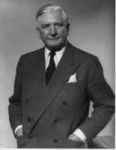 He returned to political life and after several difficult months, during which Baba left him and returned to
England, he joined the staff of the opposition publishing company "Zgoda". In 1936 he was named Managing
Director of the evening newspaper "Wieczór Warszawski" (Warsaw Evening). He quickly introduced modern
methods and machinery and also started a weekly magazine "Kronika Polski i Swiata." In 1938 he was elected
vice-president of the Publishers' Association. At the same time he was becoming influential in the "Partia Pracy"
(Labor Party -- not socialist, but a Christian-Democratic organization). In June 1938 he married a divorcee, Anna Falecka.
He returned to political life and after several difficult months, during which Baba left him and returned to
England, he joined the staff of the opposition publishing company "Zgoda". In 1936 he was named Managing
Director of the evening newspaper "Wieczór Warszawski" (Warsaw Evening). He quickly introduced modern
methods and machinery and also started a weekly magazine "Kronika Polski i Swiata." In 1938 he was elected
vice-president of the Publishers' Association. At the same time he was becoming influential in the "Partia Pracy"
(Labor Party -- not socialist, but a Christian-Democratic organization). In June 1938 he married a divorcee, Anna Falecka.
September 1, 1939 Poland was invaded by the Nazis and on the 17th. by the Soviets. Warsaw was under siege for three weeks. During this time Boleslaw arranged for all the newspapers to publish a joint news bulletin which was distributed up to the moment that Nazi troops marched into the city. He was awarded the Krzyż Walecznych (Valiant Cross)
for his role in the defense of the city. All the presses were confiscated by the Nazis, but in the empty building he organized the production of food additives, which provided an economic base for survival during the years of occupation. It also provided a cover for his work as a member of the Underground Government (Delegatura Rządu). For two years he was director of the Documentation Section which documented war crimes and cataloged economic and cultural destruction and transmitted this information to the Polish Government-in-Exile in London.
Then he became Secretary of the Central Committee of the Council of National Unity, in which representatives of all the political parties met and advised and approved actions of the executive committee.
He was fortunate to avoid arrest throughout the German occupation, although there were some close calls.
After the collapse in October 1944 of the Warsaw Uprising against the Germans, the Underground Government continued its activities until the Soviet Army pushed out the Germans. Then he, and all the other members of the Underground Government were arrested by the Soviets. Again he was extremely lucky, he was not present when
the Sixteen leaders were arrested and subsequently tried in Moscow. Instead, he was arrested on his way to the fatal meeting, at the railway station at Piotrków on March 25, 1945 and transported directly to a prison camp in the northern Ural mountains, without trial. Somehow, he managed to be included in a group of Germans that were being repatriated to communist East Germany, and then made his back to Warsaw just before Christmas 1945.
He went back to work for the Partia Pracy helping to prepare for the elections. These took place in January 1947, but were run by the communist police so that only communist delegates were elected, and hundreds of opposition candidates were either arrested or escaped to the West. The government needed my father's expertise and used him for negotiating the sale of Polish coal to Sweden and the Netherlands. Upon his return from one such trip, he was warned by a friend that he was about to be arrested by the UB (Communist political police). He still had his passport and got on the next plane back to Stockholm. May 1, 1948 he left Poland for the last time.
In exile, he continued his political work, first in Paris, then in March 1952 he received a visa to the
United States. In September 1954 the Assembly of Captive European Nations, ACEN, was organized in New York. He was one of the Polish delegates and for 16 years was the chairman of its committee for social and economic affairs. In 1958 he became a member of the Polish Council of National Unity and was chairman of its American section. In 1971, after an accident, he retired and moved to Chicago. He died suddenly, as a result of a stroke, 19 January 1976.

